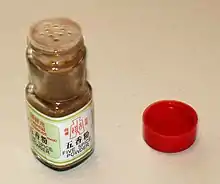Five-spice powder
Five-spice powder (Chinese: 五香粉; pinyin: wǔxiāng fěn) is a spice mixture of five or more spices used predominantly in almost all branches of Chinese cuisines and Vietnamese cuisine.[1] The five flavors of the spices (sweet, bitter, sour, salty, and pungent) refers to the five traditional Chinese elements.[2]
| Five-spice powder | |||||||||||||||||||||
|---|---|---|---|---|---|---|---|---|---|---|---|---|---|---|---|---|---|---|---|---|---|
 Five-spice powder | |||||||||||||||||||||
| Chinese name | |||||||||||||||||||||
| Chinese | 五香粉 | ||||||||||||||||||||
| Literal meaning | "five-spice powder" | ||||||||||||||||||||
| |||||||||||||||||||||
| Vietnamese name | |||||||||||||||||||||
| Vietnamese | ngũ vị hương | ||||||||||||||||||||
| Chữ Hán | 五味香 | ||||||||||||||||||||
Ingredients

While there are many variants, a common mix is:[3]
- Star anise (bājiǎo 八角)
- Cloves (dīngxiāng 丁香)
- Chinese cinnamon (ròuguì 肉桂)
- Sichuan pepper (huājiāo 花椒)
- Fennel seeds (xiǎohuíxiāng 小茴香)
Other recipes may contain anise seed, ginger root, nutmeg, turmeric, Amomum villosum pods (shārén 砂仁), Amomum cardamomum pods (báidòukòu 白豆蔻), licorice, Mandarin orange peel or galangal.
In Southern China, Cinnamomum loureiroi and Mandarin orange peel are commonly used as substitutes for Cinnamomum cassia and cloves respectively. These ingredients collectively produce southern five-spice powders' distinctive, slightly different flavor profile. In one study, the potential antioxidant capacities of Chinese five-spice powder (consisting of Szechuan pepper, fennel seed, cinnamon, star anise, and clove) with varying proportion of individual spice ingredients was investigated through four standard methods. The results suggest that clove is the major contributor to the high antioxidant capacities of the five-spice powder whereas the other four ingredients contribute to the flavor.[4]
Use
Five spice may be used with fatty meats such as pork, duck or goose. It is used as a spice rub for chicken, duck, pork and seafood, in red cooking recipes, or added to the breading for fried foods.[3] Five spice is used in recipes for Cantonese roasted duck, as well as beef stew. It is used as a marinade for Vietnamese broiled chicken. The five-spice powder mixture has followed the Chinese diaspora and has been incorporated into other national cuisines throughout Asia.
In Hawaii, some restaurants place a shaker of the spice on each patron's table. A seasoned salt can be easily made by dry-roasting common salt with five-spice powder under low heat in a dry pan until the spice and salt are well mixed.
Five-spice powder can also add complexity and savoriness to sweets and savory dishes alike.[5] It has a traditional use as an antiseptic and used to cure indigestion.[6]
References
| Wikibooks Cookbook has a recipe/module on |
- Antara Sinha. "Everything You Need to Know About Chinese Five-Spice Powder". MyRecipes. Retrieved 16 June 2020.
- Jampel, Sarah. "The Spice Blend That's Great on Pork Ribs (and Also in Cookies)". Bon Appétit. Retrieved 2020-09-21.
- Chinese Five Spice at The Epicentre
- Bi, Xinyan; Soong, Yean Yean; Lim, Siang Wee; Henry, Christiani Jeyakumar (2015-04-03). "Evaluation of antioxidant capacity of Chinese five-spice ingredients". International Journal of Food Sciences and Nutrition. 66 (3): 289–292. doi:10.3109/09637486.2015.1007452. ISSN 0963-7486. PMID 25666419. S2CID 23788102.
- "The 5-Flavor Profile of Chinese Five-Spice Powder". The Spruce Eats. Retrieved 2020-09-21.
- Bi, Xinyan; Soong, Yean Yean; Lim, Siang Wee; Henry, Christiani Jeyakumar (2015-04-03). "Evaluation of antioxidant capacity of Chinese five-spice ingredients". International Journal of Food Sciences and Nutrition. 66 (3): 289–292. doi:10.3109/09637486.2015.1007452. ISSN 0963-7486. PMID 25666419. S2CID 23788102.
